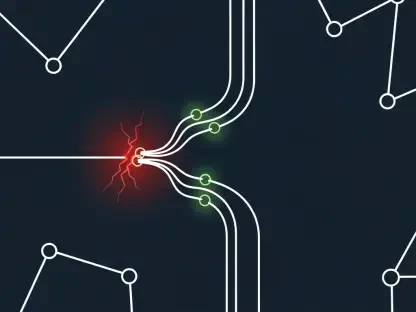In today’s rapidly evolving technological landscape, traditional network security measures are increasingly considered insufficient to address the complex challenges posed by modern cyber threats. As digital interactions grow more sophisticated and incorporate varied platforms—from cloud services to IoT devices—the vulnerabilities within traditional perimeter-based security strategies become glaringly apparent. This urgent need for a transformative approach to cybersecurity has paved the way for Zero Trust architecture, a framework that challenges old assumptions and introduces robust mechanisms to safeguard digital assets. Zero Trust fundamentally alters how security is perceived and managed by emphasizing a shift from implicit trust to rigorous validation processes. It’s a paradigm that advocates the principle: “never trust, always verify,” demanding that all users and devices attempting to access network resources must be thoroughly authenticated. This comprehensive approach to cybersecurity is not just a technological upgrade; it is an essential strategy reshaping the realms of digital security, pushing organizations to adopt measures that are both proactive and resilient.
Dissolution of Traditional Perimeters
The concept of traditional perimeter-based security revolves around creating a secure boundary within which resources are presumed safe from external threats. This approach, historically effective during simpler networking times, is failing to cope with the demands of cloud-based environments and remote workflows. Such modern configurations have dissolved the once-clear network boundaries, making traditional security paradigms obsolete. Zero Trust steps in to address these vulnerabilities by asserting that every access attempt, from inside or outside, must be thoroughly verified and authenticated. Zero Trust architectures empower organizations to redefine security beyond conventional perimeters, integrating security measures directly into various layers of the network with a focus on stringent access controls. These controls are essential in isolating sensitive data, ensuring that exposure to vulnerabilities is minimized while maintaining operational efficiency. The shift to Zero Trust is not merely a response to technological evolution; it is a critical tactic designed to anticipate threats that old security models cannot withstand. By acknowledging the interconnected nature of modern networks, Zero Trust equips enterprises with the tools necessary to protect against increasingly sophisticated adversaries, fortifying systems against potential breaches and reinforcing the notion that security is an ever-evolving discipline.
Principles of Zero Trust
Zero Trust architecture is anchored in several core principles, each playing a crucial role in ensuring comprehensive security across dynamic networks. One fundamental aspect is the concept of least privilege access, which emphasizes granting users minimal access rights necessary to perform specific tasks. This principle limits exposure, significantly reducing the risk of data breaches by shrinking potential attack vectors. Micro-segmentation, another pivotal tenet, involves dividing networks into small, manageable segments to apply fine-grained security controls. By compartmentalizing network resources, micro-segmentation enhances security measures, preventing lateral movement within networks once a breach occurs. Continuous monitoring is also central to Zero Trust, entailing constant observation and evaluation of network activities. This ensures prompt detection of anomalies, facilitating a rapid response to emerging threats while simultaneously supporting a proactive security posture. Collectively, these principles enable Zero Trust architectures to deliver heightened protection, adapting seamlessly to evolving security landscapes. They redefine access management and monitoring processes by enforcing stringent verification and validation protocols. Through a detailed evaluation of user behavior and contextual factors, Zero Trust becomes instrumental in securing assets within fast-paced and expansive digital environments where traditional models falter, ultimately setting the stage for a more fortified cybersecurity stance.
Reduction in Breach Risks
The adoption of Zero Trust architecture has demonstrated significant efficacy in reducing the risks of data breaches, offering a robust defense against the myriad of threats faced by modern networks. Enterprises embracing this framework have reported notable decreases in successful attacks, with some witnessing reductions as steep as 50%, highlighting the tangible benefits of its implementation. Such outcomes are often attributed to enhanced verification processes that meticulously scrutinize every access request, ensuring that only authenticated and authorized users gain entry to sensitive resources. Zero Trust’s foundational elements, including least privilege access and micro-segmentation, play a central role in diminishing the attack surface, making unauthorized access substantially more challenging for cybercriminals to achieve. Furthermore, continuous monitoring capabilities empower organizations with real-time insights, enabling swift detection and mitigation of potential security breaches. These mechanisms collectively fortify infrastructure, securing assets against sophisticated threats that target intellectual property, personal data, and critical operational systems. For organizations poised on the brink of digital transformation, integrating Zero Trust architecture is not merely a choice but a necessity. This proactive stance in security management shields enterprises from costly breaches while ensuring compliance with regulatory standards, proving indispensable in maintaining the integrity and availability of digital services in an increasingly volatile cybersecurity landscape.
Acceleration of Cloud-Native Security
The shift towards cloud-based infrastructure in recent years has necessitated a reevaluation of security models to address new threats inherent to these environments. Zero Trust architecture effectively aligns with and enhances contemporary cloud-native security strategies, reinforcing protection as applications and services migrate to cloud platforms. A critical element in this paradigm is the Secure Access Service Edge (SASE) model, which seamlessly integrates network and security functionalities in a unified cloud service, facilitating Zero Trust principles by enforcing identity-based access controls. With SASE, organizations can efficiently manage connectivity and security across diverse locations, adapting swiftly to dynamic conditions without compromising security. Zero Trust complements SASE, supporting its capabilities through identity verification and continuous monitoring, ensuring that cloud environments remain secure despite their vast and distributed nature. Real-time assessment and enforcement of security protocols are pivotal in safeguarding data as it traverses various digital pathways. As cloud adoption accelerates, Zero Trust architecture becomes indispensable, amplifying protective measures essential for secure and uninterrupted operations in cloud ecosystems. This symbiotic relationship between Zero Trust and cloud-native strategies reflects a proactive approach to security management, empowering enterprises to navigate complex digital transitions while fortifying their defenses against evolving cyber threats, ensuring optimal security and compliance in an era marked by rapid technological advancement.
Emphasis on Identity-Centric Security
The evolution from traditional network-centric defenses to identity-centric security models is profoundly shaping how organizations approach cybersecurity within Zero Trust frameworks. This transformation underscores the importance of authenticating and validating user identities, reflecting a shift toward ensuring access rights are continually verified, rather than broadly granting permissions based solely on network position or location. Identity-centric approaches prioritize identifying users and devices with precision, fortifying security strategies by asserting rigorous validation beyond conventional boundaries. These principles are embedded within the Zero Trust architecture, placing identity as the cornerstone for secure access management in today’s complex digital ecosystem. It demands an adaptive strategy for securing networks, balancing flexibility with security demands, and reshaping how access protocols are enforced. Continuous identity authentication empowers organizations with tailored security measures, ensuring resources are protected from unauthorized entries irrespective of fluctuating network perimeters. By focusing on identity verification, Zero Trust enriches security postures, facilitating more secure collaborative environments, while maintaining control over sensitive data and services. This paradigm shift embraces a comprehensive outlook on cybersecurity, transforming how enterprises protect and manage critical assets, and propelling security strategies toward an era marked by constant vigilance, dynamic adaptation, and unwavering commitment to safeguarding against diverse threats.
Objective Conclusion
Zero Trust architecture is founded on key principles that collectively enhance security across diverse networks. A primary tenet is the principle of least privilege access, which is all about granting users only the access rights they need for their specific duties. By limiting exposure, it minimizes the risk of data breaches by reducing potential attack surfaces. Another essential principle is micro-segmentation, which involves breaking down networks into smaller, secure parts, allowing for precise security controls. This division helps to prevent lateral movement within a network when a breach occurs, thus bolstering overall security. Continuous monitoring is also a vital component of Zero Trust. It involves constant oversight and analysis of network activities to quickly detect any irregularities. This enables swift responses to new threats, thereby maintaining a proactive security stance. Altogether, these principles ensure Zero Trust architectures offer robust protection by fluidly adapting to ever-changing security needs. They transform access management and monitoring by enforcing strict verification and validation methods. By deeply analyzing user actions and contextual elements, Zero Trust becomes critical in safeguarding assets in fast-moving, broad digital settings where traditional models often fail, paving the way for a more secure cybersecurity approach.









